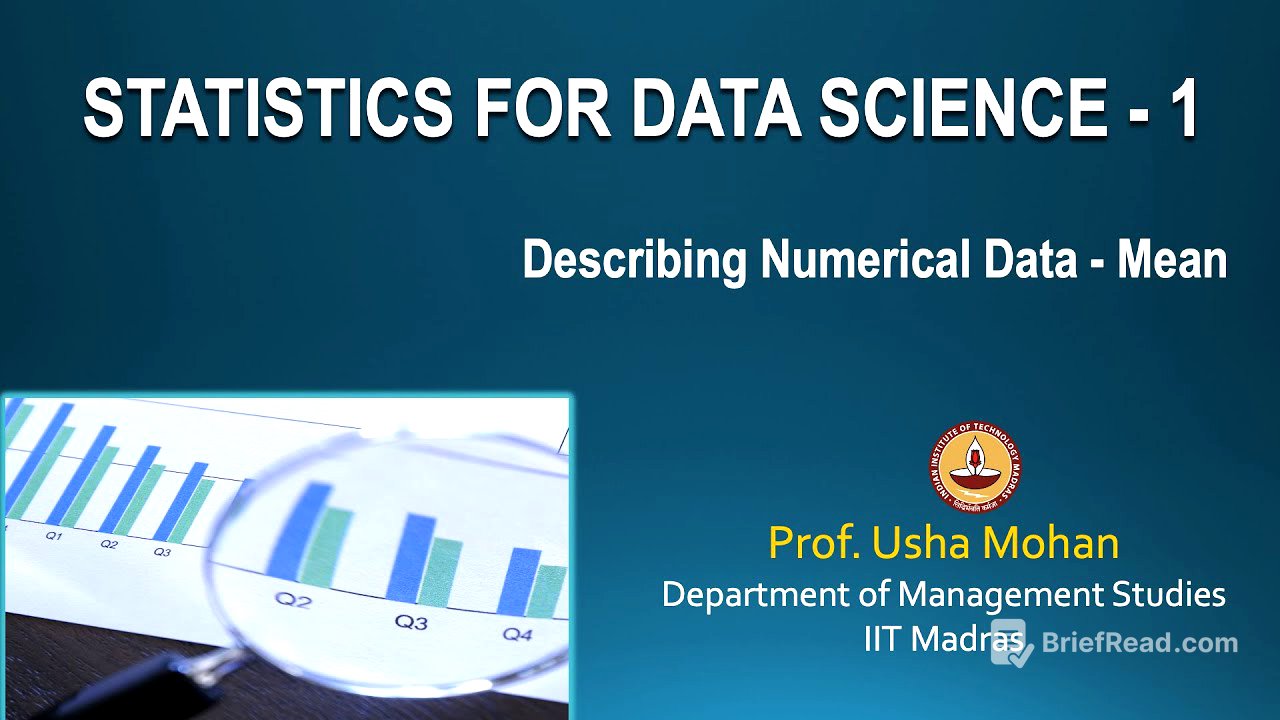TLDR;
This video explains how to summarize data using numerical summaries, focusing on measures of central tendency and dispersion. It covers the definition and calculation of the mean for both ungrouped and grouped data, and how the mean is affected by adding or multiplying a constant to each observation in the dataset.
- Measures of central tendency (mean) and dispersion are key to summarizing numerical data.
- The mean is sensitive to outliers.
- Adding a constant to each data point shifts the mean by the same constant.
- Multiplying each data point by a constant scales the mean by the same constant.
Introduction to Numerical Data Summarization [0:14]
The lecture introduces numerical summaries for data, contrasting them with descriptive measures like mode and median used for categorical variables. The focus shifts to methods for describing numerical data, aiming to develop measures that effectively summarize an entire dataset. The primary goal is to explore measures of central tendency and measures of dispersion, which are essential for understanding the typical values and variability within a dataset.
Measures of Central Tendency: The Mean [1:25]
Measures of central tendency indicate where data is concentrated, representing the most typical value in a dataset. The mean of a dataset is defined as the sum of all observations divided by the number of observations. The formula for calculating the mean involves summing the observations (x1, x2, ..., xn) and dividing by n, where n is the number of observations. The notation distinguishes between sample mean (using small n) and population mean (using capital N and the Greek letter mu), although the calculation method remains the same.
Calculating the Mean for Ungrouped Data [5:24]
The process of computing the mean for small datasets is demonstrated. The mean is calculated by summing all the data points and dividing by the number of data points. It's highlighted that the mean is sensitive to outliers, as a significant change in even one observation can substantially affect the mean.
Calculating the Mean for Grouped Data [9:34]
The lecture explains how to calculate the mean for grouped data, where data is presented with frequencies for discrete values. The mean is computed by multiplying each value by its frequency, summing these products, and then dividing by the total number of observations. For continuous data, the midpoint of each class interval is used as a representative value. The mean calculated this way is an approximation because it relies on the midpoint rather than the exact data values.
Impact of Adding a Constant to Each Observation [15:27]
The lecture investigates how adding a constant to each observation affects the mean. If a constant is added to every data point in a dataset, the mean of the new dataset is the old mean plus the same constant. This is demonstrated through an example where marks are increased by a fixed amount, showing the new mean is the original mean plus the constant.
Impact of Multiplying Each Observation by a Constant [20:12]
The lecture explores the effect of multiplying each observation in a dataset by a constant. If each data point is multiplied by a constant, the new mean is the original mean multiplied by the same constant. An example is provided where marks are scaled down by a percentage, illustrating that the new mean is the original mean scaled by that percentage.
Summary of Key Points About the Mean [23:03]
The lecture summarizes the key points about the mean, including its definition, calculation for both ungrouped and grouped data, and the effects of adding or multiplying a constant to each data point. The distinction between sample mean and population mean is clarified, with a focus on the sample mean for the remainder of the course.









